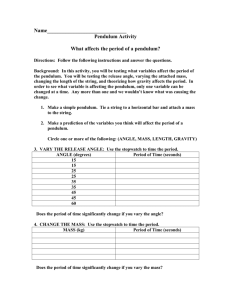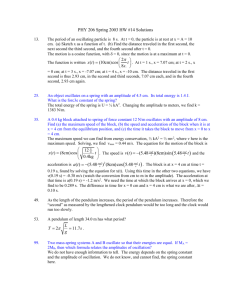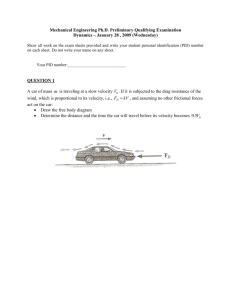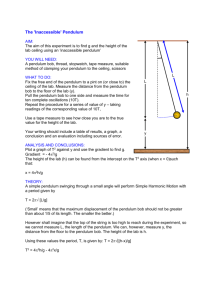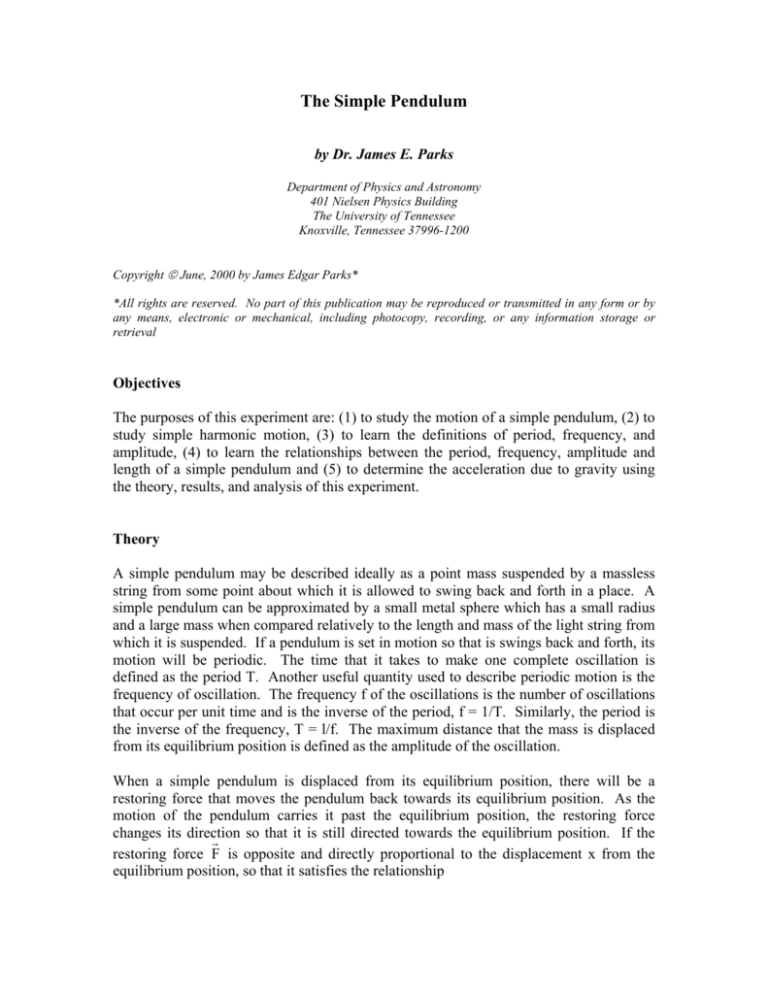
The Simple Pendulum
by Dr. James E. Parks
Department of Physics and Astronomy
401 Nielsen Physics Building
The University of Tennessee
Knoxville, Tennessee 37996-1200
Copyright June, 2000 by James Edgar Parks*
*All rights are reserved. No part of this publication may be reproduced or transmitted in any form or by
any means, electronic or mechanical, including photocopy, recording, or any information storage or
retrieval
Objectives
The purposes of this experiment are: (1) to study the motion of a simple pendulum, (2) to
study simple harmonic motion, (3) to learn the definitions of period, frequency, and
amplitude, (4) to learn the relationships between the period, frequency, amplitude and
length of a simple pendulum and (5) to determine the acceleration due to gravity using
the theory, results, and analysis of this experiment.
Theory
A simple pendulum may be described ideally as a point mass suspended by a massless
string from some point about which it is allowed to swing back and forth in a place. A
simple pendulum can be approximated by a small metal sphere which has a small radius
and a large mass when compared relatively to the length and mass of the light string from
which it is suspended. If a pendulum is set in motion so that is swings back and forth, its
motion will be periodic. The time that it takes to make one complete oscillation is
defined as the period T. Another useful quantity used to describe periodic motion is the
frequency of oscillation. The frequency f of the oscillations is the number of oscillations
that occur per unit time and is the inverse of the period, f = 1/T. Similarly, the period is
the inverse of the frequency, T = l/f. The maximum distance that the mass is displaced
from its equilibrium position is defined as the amplitude of the oscillation.
When a simple pendulum is displaced from its equilibrium position, there will be a
restoring force that moves the pendulum back towards its equilibrium position. As the
motion of the pendulum carries it past the equilibrium position, the restoring force
changes its direction
so that it is still directed towards the equilibrium position. If the
G
restoring force F is opposite and directly proportional to the displacement x from the
equilibrium position, so that it satisfies the relationship
The Simple Pendulum
G
G
F=-k x
(1)
then the motion of the pendulum will be simple harmonic motion and its period can be
calculated using the equation for the period of simple harmonic motion
T = 2π
m
.
k
(2)
It can be shown that if the amplitude of the motion is kept small, Equation (2) will be
satisfied and the motion of a simple pendulum will be simple harmonic motion, and
Equation (2) can be used.
θ
θ
l
θ T
T
x
a
F
F = mg sin θ
mg
b
θ
mg
c
Figure 1. Diagram illustrating the restoring force for a simple pendulum.
The restoring force for a simple pendulum is supplied by the vector sum of the
gravitational force on the mass. mg, and the tension in the string, T. The magnitude of
the restoring force depends on the gravitational force and the displacement of the mass
from the equilibrium position. Consider Figure 1 where a mass m is suspended by a
string of length l and is displaced from its equilibrium position by an angle θ and a
distance x along the arc through which the mass moves. The gravitational force can be
resolved into two components, one along the radial direction, away from the point of
suspension, and one along the arc in the direction that the mass moves. The component
of the gravitational force along the arc provides the restoring force F and is given by
F = - mg sinθ
Revised 10/25/2000
2
(3)
The Simple Pendulum
where g is the acceleration of gravity, θ is the angle the pendulum is displaced, and the
minus sign indicates that the force is opposite to the displacement. For small amplitudes
where θ is small, sin θ can be approximated by θ measured in radians so that
Equation (3) can be written as
F = - mg θ .
(4)
x
, the arc length divided by the length of the pendulum or the
l
radius of the circle in which the mass moves. The restoring force is then given by
The angle θ in radians is
F = - mg
x
l
(5)
and is directly proportional to the displacement x and is in the form of Equation (1) where
mg
k=
. Substituting this value of k into Equation (2), the period of a simple pendulum
l
can be found by
m
mg
l
T = 2π
( )
(6)
and
T = 2π
l
.
g
(7)
Therefore, for small amplitudes the period of a simple pendulum depends only on its
length and the value of the acceleration due to gravity.
Apparatus
The apparatus for this experiment consists of a support stand with a string clamp, a small
spherical ball with a 125 cm length of light string, a meter stick, a vernier caliper, and a
timer. The apparatus is shown in Figure 2.
Procedure
1. The simple pendulum is composed of a small spherical ball suspended by a long, light
string which is attached to a support stand by a string clamp. The string should be
approximately 125 cm long and should be clamped by the string clamp between the
two flat pieces of metal so that the string always pivots about the same point.
Revised 10/25/2000
3
The Simple Pendulum
Figure 2. Apparatus for simple pendulum.
2. Use a vernier caliper to measure the diameter d of the spherical ball and from this
calculate its radius r. Record the values of the diameter and radius in meters.
3. Prepare an Excel spreadsheet like the example shown in Figure 3. Adjust the length
of the pendulum to about .10 m. The length of the simple pendulum is the distance
from the point of suspension to the center of the ball. Measure the length of the string
ls from the point of suspension to the top of the ball using a meter stick. Make the
following table and record this value for the length of the string. Add the radius of
the ball to the string length ls and record that value as the length of the pendulum
l = ls + r .
4. Displace the pendulum about 5º from its equilibrium position and let it swing back
and forth. Measure the total time that it takes to make 50 complete oscillations.
Record that time in your spreadsheet.
5. Increase the length of the pendulum by about 0.10 m and repeat the measurements
made in the previous steps until the length increases to approximately 1.0 m.
6. Calculate the period of the oscillations for each length by dividing the total time by
the number of oscillations, 50. Record the values in the appropriate column of your
data table.
Revised 10/25/2000
4
The Simple Pendulum
Figure 3. Example of Excel spreadsheet for recording and analyzing data.
7. Graph the period of the pendulum as a function of its length using the chart feature of
Excel. The length of the pendulum is the independent variable and should be plotted
on the horizontal axis or abscissa (x axis). The period is the dependent variable and
should be plotted on the vertical axis or ordinate (y axis).
8. Use the trendline feature to draw a smooth curve that best fits your data. To do this,
from the main menu, choose Chart and then Add Trendline . . . from the dropdown
menu. This will bring up a Add Trendline dialog window. From the Trend tab,
choose Power from the Trend/Regression type selections. Then click on the Options
tab and select Display equations on chart option.
9. Examine the power function equation that is associated with the trendline. Does it
suggest the relationship between period and length given by Equation (7)?
10. Examine your graph and notice that the change in the period per unit length, the slope
of the curve, decreases as the length increases. This indicates that the period
increases with the length at a rate less than a linear rate. The theory and Equation (7)
predict that the period depends on the square root of the length. If both sides of
Equation 7 are squared then
Revised 10/25/2000
5
The Simple Pendulum
T2 =
4π 2
l.
g
(8)
If the theory is correct, a graph of T2 versus l should result in a straight line.
11. Square the values of the period measured for each length of the pendulum and record
your results in the spreadsheet.
12. Use the chart feature again to graph the period squared, T2, as a function of the length
of the pendulum l . The period squared is the dependent variable and should be
plotted on the y axis. The length is the independent variable and should be plotted on
the x axis.
13. Examine your graph of T2 versus l and check to see if there is a linear relationship
between T2 and l so that the data points lie along a line.
14. Use the trendline feature to perform a linear regression to find a straight line that best
fits your data points. This time from the Add Trendline dialog window. choose
Linear from the Trend/Regression type selections. Click on the Options tab and once
again select the Display equations on chart option. This should draw a straight line
that best fits the data and should display the equation for this straight line.
4π 2
4π 2
, x= l , and b=0.
l , is of the form y=ax+b where y=T2, a =
g
g
A graph of T2 versus l should therefore result in a straight line whose slope, a, is
4π 2
. From the equation for the trendline, record the value for the slope, a,
equal to
g
15. Equation (8), T 2 =
and from the equation a=
4π 2
find g, the acceleration due to gravity.
g
16. Compare your result with the accepted value of the acceleration due to gravity
9.8 m/s2. Calculate the percent difference in your result and the accepted result.
% Difference = [(your result - accepted value)/accepted value] x 100%
17. Using the accepted value of the acceleration due to gravity and Equation 7 calculate
the period of a simple pendulum whose length is equal to the longest length measured
in Table 1. Compare this theoretical result with the measured experimental result and
calculate the percent difference.
% Difference = [(Experimental Result - Theoretical Result)/Theoretical Result] x 100%.
18. The equation for the period of a simple period, Equation (7), was developed by
assuming that the amplitude is small. The range of amplitudes over which Equation
Revised 10/25/2000
6
The Simple Pendulum
(7) is valid is to be determined by measuring the period of a simple pendulum with
different amplitudes.
19. Adjust the length of the pendulum to about 0.6 m. Measure the period of the
pendulum when it is displaced 5°, 10°, 15°, 20°, 25°, 30°, 40°, 50°, and 60° from its
equilibrium position. Make a table to record the period T as a function of the
amplitude A.
20. Using your data, make a graph of the period versus the amplitude.
21. Measure the length of the pendulum and use Equation (7) to calculate the period of
the pendulum. Add this theoretical point to your graph for the period with zero
amplitude.
22. Examine your graph for the behavior of the period with amplitude. What conclusions
can you draw from your data regarding the range of amplitudes over which Equation
(7) is valid?
Questions
1. How would the period of a simple pendulum be affected if it were located on the
moon instead of the earth?
2. What effect would the temperature have on the time kept by a pendulum clock if the
pendulum rod increases in length with an increase in temperature?
3. What kind of graph would result if the period T were graphed as a function of the
square root of the length, l .
4. What effect does the mass of the ball have on the period of a simple pendulum?
What would be the effect of replacing the steel ball with a wooden ball, a lead ball,
and a ping pong ball of the same size?
Revised 10/25/2000
7







